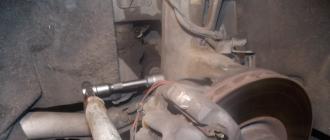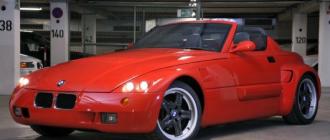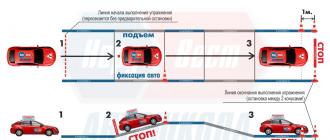Many car owners are concerned about why the alternator belt whistles. An unpleasant situation when the generator belt makes a grinding and whistling noise, gets on your nerves, and makes it impossible to concentrate on the road. However, the cause of the whistle is not always the belt. Let's find out why the generator whistles?
Belt and its universal functions
ATTENTION! A completely simple way to reduce fuel consumption has been found! Don't believe me? An auto mechanic with 15 years of experience also didn’t believe it until he tried it. And now he saves 35,000 rubles a year on gasoline!
Belt drive is the best way to transmit torque to the rotor of a generating device, invented today. This method has been successfully used for many years, differing from other methods in its simplicity. Belt transmission does not require complex and numerous components - two pulleys with shafts connected to each other by an elastic belt are sufficient.
Here the belt itself becomes a universal part, because it has many functions. First of all, the main task is to ensure the rotation of the pulleys.
Note. It is important that the belt is not just elastic and moderately rigid. One part of the element is specially tightened to provide a difference in tension, and, accordingly, to solve the issue of traction force and its efficiency.

The belt gives transmission to the generator rotor, which must constantly rotate during operation. car engine. The belt in this case ensures not only this, but also the clarity of the transmission, smoothing out the shocks and jerks that inevitably come from the crank shaft.
The belt ensures silent rotation, and high-quality products can simultaneously be moderately rigid and durable, thereby withstanding long-term loads.
Another advantage of the belt is its compactness. It takes up little space while simultaneously performing tasks on a scale disproportionate to its size. The generator, water pump, air conditioning compressor, power steering pump - all of this works thanks to the rotation of the belt.
It is not surprising that after such loads the belt cannot withstand. The disgusting “clanging” emitted by a problematic belt is the very whistle we are writing about. The reason is belt slippage. Sometimes this whistle is so strong that it can be heard at a very long distance.
Other causes of whistling

Why does the belt slip? If the load is to blame, then after replacement everything should return to normal. However, the noise continues with the new belt. Some kind of opportunity. No need to panic. It is better to find the reason for all this in the first place.
Experts advise taking the following actions:
- visually inspect the belt, checking it for integrity (even new products today are found to be defective and of poor quality);
- check the shaft and pulleys for cleanliness (oil and other dirt can easily cause whistling);
- diagnose the degree of tension (weak tension also causes noise);
- check the alignment of the pulleys (if two pulleys are not located in relation to each other in the same plane, the belt will not rotate smoothly, thereby touching certain parts with its edges and whistling).
Despite the fact that the belt performs many tasks, the designers did not ignore the load moment. Part of it, of course, is taken over by the pulleys. And in them, according to many experts, one should look for the causes of whistling. Moreover, if it makes an unpleasant sound and a new belt has been tested for quality according to all the rules.
The first thing that takes the pulleys out of their normal state, so to speak, is liquid that gets on the surface. Oil, coolant, and gasoline can get on the pulley or belt itself. This causes slippage and a strong whistling sound.
If everything was checked carefully, but the cause of the whistle was not found, the generator itself comes into question. It also happens that bearings emit a whistling noise when they are heavily worn. In such cases, the generating device is disassembled and the bearings are replaced with new ones.
Varieties of whistling

It is customary to distinguish whistling by the nature of its occurrence. For example, a whistle may appear only when it is cold, then disappear. Therefore, it is equally important to know how the alternator belt whistles.
Whistling when cold is a common headache for Russian car owners. There are several reasons.
- The grease for the generator bearings is incorrectly selected. Because of this, in cold weather the composition becomes denser, the pulley cannot easily rotate the rotor. Everything goes away as soon as the engine warms up and the lubricant “defrosts”. The solution to this problem is simple - replace the anti-adhesive with a composition that is more cold-resistant.
- Weak belt tension. An engine that is simply not able to start working dynamically “when cold” requires time to warm up. During this period, a weakly tensioned belt lacks the strength to “accelerate” on the pulleys. It slips and whistles, but only until the motor begins to rotate quickly and evenly.
- The pulley itself is jammed. This also only happens “when cold” until the car parts are properly heated. You can check whether the pulley is the cause of the whistling yourself. You need to turn the generator pulley by hand, first taking off the belt. If the pulley rotates slowly or cannot be turned at all, serious repairs and even replacement are needed.
Another option for whistling is noise that occurs only when the engine is under load. This type of whistling is mostly caused by weak belt tension.
Belt whistling: reasons
| CAUSES OF WHISTLING | WHY IS IT WHISTLING? | WHAT TO DO |
|---|---|---|
| Generator belt | It becomes unusable due to natural wear and tear. Due to grains of sand that fell on the surface of this belt and ate into the grooves. | Check the condition of the belt; if there are cracks on its surface, stuck grains of sand are visible or threads are sticking out, replace the generator belt immediately. |
| Poor tension | Often, after replacing the alternator belt, it is not tensioned well, resulting in the alternator belt whistling during loads, as well as in wet weather. | Tighten the belt. |
| Pulley or pulleys | If there is wear on the pulleys or they have been changed (installation of non-original pulleys is fraught with whistling and other problems), the appearance of whistling is quite understandable. A loose fit of the poly V-belt to the grooves on the pulley impairs adhesion, as a result the generator belt begins to slip and whistle. | Replacement or repair of pulley(s) |
| Liquid got on the belt | Often the generator belt whistles due to liquid (antifreeze, oil, fuel, etc.) getting on its working surface. | Check for oil and coolant leaks. Eliminate them. Replace the belt. | Due to high consumption electric current, the load on the generator increases, therefore, the resistance increases magnetic field stator rotation. As a result, the generator seems to “slow down” the belt, resulting in surface friction, which is expressed in the form of an unpleasant whistle. | Turn off unnecessary electrical consumers. Check the generator and the entire power circuit. |
| The generator bearing or tension roller is faulty | You can check whether there is play in the generator bearing only by removing it, or try to shake the generator pulley; in this case, the location of the generator plays a big role. | Replace the bearing. In case of malfunction tension roller, it will also have to be replaced. |
Welcome, friends, to the DIY car repair website. Owners of VAZ cars often encounter a situation where the alternator belt whistles when starting the engine.
In such a situation, most beginners see only one way out - replacing the supposedly worn out element. In reality, you shouldn't make rash decisions.
Sweetness can be caused by a number of reasons that can be eliminated with your own hands and at minimal cost.
Features and possible causes of alternator belt whistling
The main purpose of the generator is to power the electrical equipment of the car. But how is constant rotation of the rotor ensured?
There are special pulleys on the engine crankshaft and the generator shaft on which the belt is tensioned. After starting the engine, the crankshaft begins to rotate, driving the generator rotor.
The appearance of a squeak is due to increased friction of the belt on the generator pulley ( crankshaft) or normal slippage.
In practice, the causes of squeaking and whistling may be the following:
- Increased belt wear. Sometimes even additional tension does not help.
- Contact of various liquids (antifreeze, oil, etc.) on the generator pulley (crankshaft) or directly on the belt.
- Poor quality belt.
- Bearing wear in the generator.
This malfunction most often occurs at increased loads. The bearing may whistle or rattle. In such a situation, only replacement with your own hands or at a service station can help out.
Diagnosis and elimination of alternator belt whistling
Is the alternator belt whistling in your car? - Don't panic. The first thing you need to do is do a little diagnostics. Inspect the belt for obvious damage.
Check that it is well tensioned and that there is no obvious shift in the pulley line. Special attention Pay attention to the surface of the belt - there should be no liquids on it.
After the inspection, you will be able to draw preliminary conclusions and make a decision on further repairs:
If the belt is visually damaged, there are serious cracks on the surface, and the edges are frayed, then you cannot do without replacing the belt. At the same time, buy only original parts for your VAZ model.
Otherwise, after a couple of thousand kilometers you will encounter this problem again. By the way, low-quality Chinese fakes often “whistle” immediately after installation.
Is there obvious contamination on the belt (oil, antifreeze)? – Carefully clean the belt of excess dirt (if possible). If dirt has become embedded in the product and cleaning does not produce visible results, then it is better to replace the alternator belt.
If no external problems are found, move on to the mechanical part. Check tension. To do this, press the belt at the midpoint between the crankshaft and generator pulleys.
The optimal level of deflection is about 6-8 mm. If this parameter turns out to be larger or smaller, adjustment is necessary.
Let us immediately note that for each VAZ model the setup process may be slightly different. We will consider the general case.
Prepare a ratchet handle, a spanner set to “19”, a deep socket set to “17”, and also reserve 15-20 minutes of personal time.
Alternator belt tightening sequence
Using a “17” wrench, slightly unscrew the upper fastening nut connecting the generator to the bracket.
Loosen the fastening nut at the bottom (just unscrew it a few turns).
If you need to loosen the belt, grab the generator and pull it towards you (if you need to tighten the belt, pull it away from you). After which it is necessary to tighten the nuts and check the operation of the generator.
Before starting the engine, turn on several main consumers, for example, the stove, high beam and heating. If the whistle disappears and the charging level remains at a normal level, then the work can be considered successful.
At the same time, remember that over-tightening is also unacceptable (this can lead to increased wear on the pulleys and belt).
There are situations when the alternator belt whistles from time to time, for example, when the temperature drops or humidity increases outside.
In this case, you can use special additives (sold in standard cans). The method of application is very simple.
It is necessary to spray the composition on the inside of the belt and pulleys. The cost of such products is from 500 to 1500 rubles.
If your car's alternator belt squeaks, you shouldn't immediately rush to the service station and make expensive repairs.
In most cases, the problem can be solved much easier and in a few minutes. And now you know how it's done. Good luck on the roads and of course no breakdowns.
The operation of cars, both domestic and foreign, is sometimes accompanied by an unpleasant whistling sound. The generator drive belt whistles. This phenomenon occurs more often in cold or rainy weather, when the engine is not warmed up.
It is possible to operate such a vehicle, but the whistle means that the drive is slipping on the pulleys without rotating the generator shaft. Accordingly, the battery does not receive the necessary charge.
The problem may be caused by other, more serious reasons. Why does the alternator belt whistle? What is the problem and what needs to be done to fix it?
Reasons for whistling
The cause of the whistling may be hidden both in the belt itself and in nearby units. When a car owner asks for help, it often turns out that the generator is whistling.
Belt faults
There may be several reasons why the VAZ-2110 alternator belt whistles. However, the first place in terms of frequency of occurrence is the wear and tear of the material from which it is made. The rubber stretches, loses its shape, and begins to slip. 
Diagnostics is carried out visually, based on the degree of belt tension. If it sags and can be easily turned by hand (while the pulleys remain motionless), then the cause of the malfunction can be considered found.
In addition to the above, the belt drive whistles when the pulleys are oiled. This usually happens on older engines, where oil seeps through seals and gaskets. The generator drive on Priora and other VAZ models is not geared. Therefore, it easily slides over oily surfaces. Diagnosis is carried out visually.
The drive may not whistle constantly, but periodically whistle for some time after a cold start in winter. In general, if the situation returns to normal after warming up, no intervention is required. The fact is that the rubber from which the element is made becomes hard in the cold and does not adhere tightly to the surfaces of the pulleys. As it warms up, it takes on a working form and the whistling stops.
Generator faults
The problem with the whistling of the VAZ-2107-VAZ-2101 generator and the entire front-wheel drive line of cars usually lies in a collapsed front cover bearing. In this case, both the bearing itself and the belt slipping along the jammed pulley can make noise. The malfunction is determined “by eye”. 
In some cases, alternator drive slippage may be caused by a misaligned alternator pulley or crankshaft pulley. The belt begins to move at an angle, touching the side surfaces. At the same time, even a new alternator belt will whistle. A breakdown can be determined by severe wear on the belt drive. The drive “eats” on the sides.
Possible repairs
What to do in this situation? The solution depends on the identified malfunction. A loose drive should be tightened. Kalina cars and other front-wheel drive VAZA models have a tension bolt that allows you to adjust the degree of belt tension.
To carry out the manipulation, loosen the fastening bolts, then tighten the adjustment bolt a few turns, achieving optimal tension. A correctly tensioned drive should bend no more than 1 cm under hand pressure. If this cannot be achieved even with the bolt tightened to maximum, the belt should be replaced.
If the pulleys become oily, the drive should be removed and the inside should be wiped with alcohol or gasoline. Pulleys are cleaned in the same way. If the belt has been in an oily state for a long time, it is recommended to replace it, since fuels and lubricants destroy rubber. Also, current seals and gaskets must be changed.
In cases where the alternator belt whistles “when cold,” repair is not required. It is permissible to slightly increase the belt tension. However, if the whistling noise disappears after warming up, this is not necessary.
If, as a result of diagnostics, it was revealed that the front bearing of the generator is whistling, it is replaced. To do this, remove the unit from the car, dismantle the front cover and, after removing the faulty bearing, press in a new one. This is also done when the pulley is skewed and the generator shaft is jammed. 
Prevention
You can prevent slipping of the generator drive by timely checking and correcting its tension level, replacing the belt if there is damage or severe wear.
It is important to monitor the condition of the engine seals and the cleanliness of the engine compartment. At the first sign of wear on the generator bearing, it is necessary to replace it.
During operation vehicle the motorist faces various troubles. So, over time, the steering wheel begins to play and the suspension begins to knock. Sometimes it whistles. Why does this happen? This problem can catch a motorist at the most inopportune moment. Well, let's look at why the alternator belt whistles on the Kia Rio (sedan) and other cars.
Belt characteristics
First, let's look at what this element is responsible for. As you know, it is often used in a car. Thanks to it, correct gas distribution is carried out (if we are talking about the timing unit), the operation of the hydraulic booster, air conditioning and generator.
Maintaining optimal voltage on-board network- a guarantee of serviceability of any car. This is why it is so important to keep your generator in working condition. The part itself is reliable. However, the alternator belt may whistle. Why is this happening? The fact is that the element loses adhesion to the crankshaft pulley. And this can already happen for various reasons. Let's look at which ones below.
Natural wear and tear
As you know, this element is subject to heavy loads. Therefore, it must be durable and at the same time elastic. The generator belt is made of rubber with a reinforcing filler. The service life of this product is 60 thousand kilometers. Of course, the resource directly depends on the load on the generator. But if there is a whistle from the engine compartment, it is worth remembering how long you have not changed this element. Remember that over time the belt loses its quality.

By the way, judging by the reviews, the most durable and hardy is This element has the shape of a trapezoid when cut. This allows it to withstand heavy loads. However, the mechanism is not designed for reverse bending. Therefore, it is not used on all cars.
Cleanliness of parts
Few people know that engine compartment It also needs to be washed periodically. Moreover, this is not done for aesthetic pleasure. The fact is that when heavily soiled, the belt drive loses grip with the pulley. A characteristic whistle begins. In addition, dust particles act as an abrasive inside. As a result, the question arises: “Why is the new alternator belt whistling?” But it’s not just dust that can contribute to this problem.

If the engine gasket leaks oil, it may spray onto the crankshaft pulley. As a result, the belt loses its rigid adhesion to the shaft. The clanging and whistling begins. This is why it is so important to keep the engine compartment clean. By the way, after washing you can find traces of oil leakage. This will allow you to timely diagnose a breakdown of the gasket or oil seal and fix the problem.
Bearing
This element can also cause a whistle. Why does this mechanism fail? As with all bearings, the lubricant can be washed out here, which compromises the integrity of the race. Moreover, it is impossible to determine the cause externally.

The bearing will be like new. But as soon as it starts working (that is, starts rotating), you will hear a characteristic noise. This element is non-removable and cannot be repaired. If it fails, only replacement will help.
Tension
This is perhaps one of the most common reasons why the alternator belt whistles on the VAZ-2110 and other domestic cars. Owners of foreign cars are not immune from this problem. Whistling can occur for two reasons. This is a very weak or too tight belt tension. Moreover, the problem may disappear and appear again. So, if the belt is tightly tightened, the whistle will occur only in the cold season. As soon as the engine warms up, the belt regains its shape and the sound stops. But this does not mean that you can continue to drive with such a problem. This significantly reduces the life of the belt and bearing.
Correct pulley line
This is another reason why the alternator belt whistles. This problem also happens on Priora. So, when there is a whistle, it is worth checking the alignment of the upper and lower pulleys. They must be on the same level. Even with a slight slope, the contact patch is reduced several times. The mechanism will emit a characteristic squeak.
How to tighten up?
Checking the tension level without tools is quite simple. So, if you press your finger on the middle part of the belt, it should bend by 6-8 millimeters. If the element is tight or too tight, the situation needs to be corrected. Let's look at how to do this using an example front wheel drive cars VAZ.

So, we will need ring wrenches “17” and “19” (or better yet, with a ratchet and a head). The setup process takes no more than ten minutes. So, let's get to work. First you need to unscrew the mounting nut that secures the generator and bracket on top. Next, unscrew the same nut at the bottom. It is enough to loosen it a few turns. If you need to tighten the element, you should grab the alternator and pull the belt away from you. Next, tighten the corresponding nuts and check the tension level. If the belt is too tight and needs to be loosened, we perform a similar operation. However, here we need to pull the generator towards us. So, tighten all the bolts and start checking. If the tension is at the level of six to eight millimeters, start the engine and turn on all the main consumers of electricity. These are optics, air conditioning, stove and so on. There is no point in turning on music, because we need to listen to the whistle of the belt. If there is no noise, the work is considered successful.
Conclusion
So, we found out why the alternator belt whistles. As you can see, this can happen for various reasons. But first of all, you should check the tension level. In 80 percent of cases, the alternator belt whistles precisely because of this. Also remember that overtightening the mechanism can lead to increased wear of the bearings and the pulley itself. Stick to the golden mean, namely a parameter of 6-8 millimeters when deflecting in the middle section. And you can adjust the tension level yourself, using two keys. Therefore, if the alternator belt whistles, it is not necessary to go to a service station to find the problem. Perhaps the reason lies in its elementary incorrect tension.






